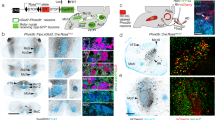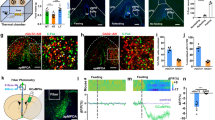Abstract
THIRSTY rats lick avidly and persistently at a stream of air flowing through a drinking tube1, behaviour which is not dependent on the previous experience of drinking water through a drinking tube2 or on olfactory cues3. The most plausible explanation for the rewarding property of airlicking is that it is a result of evaporative cooling of the orolingual region. Heating and humidifying the air so as to decrease its cooling power reduces airlicking4. In addition, tongue cooling alone is rewarding for thirsty rodents5, and cold water has a greater satiating effect on water intake than warm water6. These observations seem to indicate that because airlicking leads to tongue cooling, it thereby reduces thirst and the reduction of thirst reinforces airlicking. Airlicking cannot be mediated entirely by tongue temperature receptors, however, because lingual denervation by bilateral section of the lingual, chorda tympani and one branch of the glossopharyngeal nerves has no influence on airlicking7. It is not clear whether central stimuli that affect water drinking and satiation will similarly influence airlicking. Temperature-sensitive neurones are located in the preoptic area (POA) and hypothalamus8, and since cooling of the POA reduces water intake in thirsty animals9, we tried to determine if cooling of the POA reduced airlicking. We found that acquisition of airlicking behaviour was completely blocked by POA cooling in naive animals and reduced about 50% in experienced animals.
This is a preview of subscription content, access via your institution
Access options
Subscribe to this journal
Receive 51 print issues and online access
$199.00 per year
only $3.90 per issue
Buy this article
- Purchase on Springer Link
- Instant access to full article PDF
Prices may be subject to local taxes which are calculated during checkout
Similar content being viewed by others
References
Hendry, D. P., and Rasche, R. H., J. comp. Physiol. Psychol., 54, 477–483 (1961).
Riccio, D. C., Hamilton, D. M., and Treichler, F. R., Psychonom. Sci., 7, 295–296 (1967).
Carr, W. J., Levin, B. H., and Dissinger, M. L., Psychonom. Sci., 13, 23–24 (1968).
Mendelson, J., Chillag, D., and Paramesvaran, M., Behav. Biol., 8, 357–365 (1973).
Mendelson, J., and Chillag, D., Science, 170, 1418–1421 (1970).
Kapatos, G., and Gold, R. M., Science, 176, 695–686 (1972).
Mendelson, J., and Zec, R., Physiol. Behav., 8, 711–714 (1972).
Eisenman, J. S., in Essays on Temperature Regulation (edit. by Bligh, J., and Moore, R.), (North-Holland, Amsterdam, 1972).
Banet, M., and Seguin, J. J., J. appl. Physiol., 29, 385–388 (1970).
Corbit, J. D., J. comp. Physiol. Psychol., 83, 394–411 (1973).
König, J. F. R., and Klippel, R. A., The Rat Brain: A Stereotaxic Atlas of the Forebrain and Lower Brainstem (Williams and Wilkins, Baltimore, 1963).
Author information
Authors and Affiliations
Rights and permissions
About this article
Cite this article
CARLISLE, H., LAUDENSLAGER, M. Inhibition of airlicking in thirsty rats by cooling the preoptic area. Nature 255, 72–73 (1975). https://doi.org/10.1038/255072a0
Received:
Accepted:
Issue Date:
DOI: https://doi.org/10.1038/255072a0
Comments
By submitting a comment you agree to abide by our Terms and Community Guidelines. If you find something abusive or that does not comply with our terms or guidelines please flag it as inappropriate.



